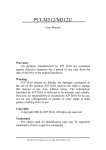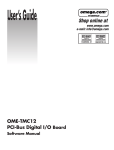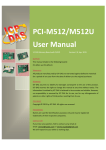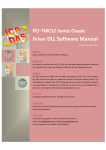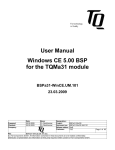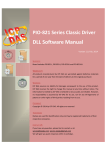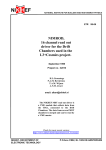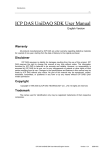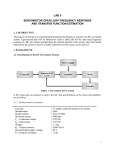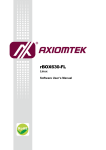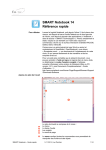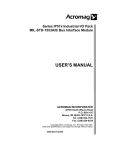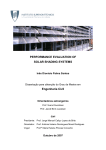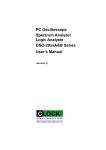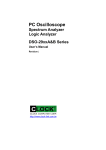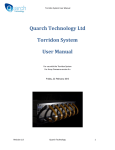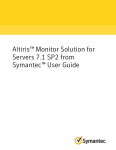Download Manual
Transcript
PCI-M512/M512U User Manual Warranty All products manufactured by ICP DAS are warranted against defective materials for a period of one year from the date of delivery to the original purchaser. Warning ICP DAS assumes no liability for damages consequent to the use of this product. ICP DAS reserves the right to change this manual at any time without notice. The information furnished by ICP DAS is believed to be accurate and reliable. However, no responsibility is assumed by ICP DAS for its use, or for any infringements of patents or other rights of third parties resulting from its use. Copyright Copyright 2002 by ICP DAS. All rights reserved. Trademark The names used for identification only may be registered trademarks of their respective companies. PCI-M512 User Manual (Ver.2.7, Jun./2010, PMH-017-27) ----- 1 Tables of Contents 1. INTRODUCTION................................................................................................4 1.1 FEATURES .......................................................................................................4 1.2 1.3 1.4 SPECIFICATIONS ..............................................................................................5 PRODUCT CHECK LIST ....................................................................................6 INSTALLATION QUICK START..........................................................................7 1.4.1 Software Installation..................................................................................7 1.4.2 get demo software and manual ..................................................................8 1.4.3 Hardware Installation................................................................................9 1.4.4 Hardware Diagnostic ................................................................................9 1.4.5 Multi-Board Diagnostic...........................................................................14 2. HARDWARE CONFIGURATION .................................................................15 2.1 2.2 BOARD LAYOUT ..........................................................................................15 IDS OF PCI-M512.........................................................................................16 2.3 2.4 2.5 2.6 BLOCK DIAGRAM OF DIO .............................................................................17 BATTERY STATUS INDICATORS .....................................................................18 BLOCK DIAGRAM OF SRAM.........................................................................20 DAUGHTER BOARDS .....................................................................................21 2.6.1 DB-16P Isolated Input Board ..................................................................21 2.6.2 DB-16R Relay Board ...............................................................................22 2.6.3 DB-24PR, DB-24POR, DB-24C ..............................................................23 2.7 PIN ASSIGNMENT ..........................................................................................24 3. DLL DRIVER.....................................................................................................25 3.0 PROGRAM ARCHITECTURE ..................................................................................26 3.1 FIND THE BOARD NUMBER..................................................................................29 3.2 FUNCTIONS OF TEST ............................................................................................30 3.2.1 PCIM512_FloatSub ....................................................................................30 3.2.2 PCIM512_ShortSub ...................................................................................30 3.2.3 PCIM512_IntSub ........................................................................................31 3.2.4 PCIM512_GetDllVersion ...........................................................................31 3.3FUNCTIONS OF DRIVER INITIALIZATION ...............................................................32 3.3.1 PCIM512_DriverInit ..................................................................................32 3.3.2 PCIM512_OpenBoard ................................................................................32 3.3.3 PCIM512_DetectBoards.............................................................................33 3.3.4 PCIM512_ReadBoardId .............................................................................34 3.3.5 PCIM512_ReadBoardStatus.......................................................................35 3.3.6 PCIM512_CloseBoard................................................................................36 PCI-M512 User Manual (Ver.2.7, Jun./2010, PMH-017-27) ----- 2 3.3.7 PCIM512_CloseAll .....................................................................................36 3.4 FUNCTIONS OF SRAM READ/WRITE.....................................................................37 3.4.1 PCIM512_WriteSramByte ..........................................................................37 3.4.2 PCIM512_WriteSramWord ........................................................................38 3.4.3 PCIM512_WriteSramDword ......................................................................39 3.4.4 PCIM512_ReadSramByte ...........................................................................40 3.4.5 PCIM512_ReadSramWord .........................................................................41 3.4.6 PCIM512_ReadSramDword .......................................................................42 3.5 FUNCTIONS OF D/I/O READ/WRITE .....................................................................43 3.5.1 PCIM512_WriteToDo.................................................................................43 3.5.2 PCIM512_ReadFromDi..............................................................................44 4. DEMO PROGRAM ..............................................................................................45 4.1 PROBLEMS REPORT .............................................................................................46 PCI-M512 User Manual (Ver.2.7, Jun./2010, PMH-017-27) ----- 3 1. Introduction The PCI-M512/PCI-M512U provides battery-backup 512 KB SRAM, 12-bit DI and 16-bit DO. In addition, the PCI-M512U supports both 5 V and 3.3 V PCI bus, while the PCI-M512 supports 5 V PCI bus only. The PCI-M512U (Universal PCI version) is designed as a drop-in replacement for the PCI-M512 (PCI version), so users can replace a PCI-M512 by a PCI-M512U directly without any software or driver modification. Users can use the DB-16P to connect the input ports (CN2) for isolation purpose, or use DB-16R to interface to the output ports (CN1) for relay control. The PCI-M512/PCI-M512U is equipped with two Li-batteries to maintain the content of the 512 KB SRAM when PC power loss occurs. The two Li-batteries can continue supplying power to the SRAM to retain the important data for 10 years. The twobattery design also makes it safe to replace new batteries without losing data; when one battery is taken out for replacing a new one, the other continues to provide power to the SRAM. 4 LED indicators on the board are provided for giving clear understanding of the battery states such as normal, low voltage or fault. The PCI-M512/PCI-M512U is an ideal solution for improving system reliability. 1.1 Features z z z z z z z z On-board 512 KB SRAM Two Li-batteries, BT1 & BT2, for battery-backup the data of SRAM LED indicators for Li-batteries states: normal, low voltage, fault 16-bit general purpose TTL-compatible D/O 12-bit general propose TTL-compatible D/I (DI4 ~ 15) 4-bit battery status read back(DI0 ~ 3) [PCI-M512 only] PCI card, supports 5 V PCI bus. [PCI-M512U only] Universal PCI card, supports both 5 V and 3.3 V PCI bus. PCI-M512 User Manual (Ver.2.7, Jun./2010, PMH-017-27) ----- 4 1.2 Specifications Model Name PCI-M512 PCI-M512U Digital Input Channels 12 Compatibility 5 V/TTL Input Voltage Logic 0: 0.8 V max. Logic 1: 2.0 V min. Response Speed 1.4 MHz(Typical) Digital Output Channels 16 Compatibility 5 V/TTL Output Voltage Logic 0: 0.4 V max. Logic 1: 2.4 V min. Output Capability Sink: 2.4 mA @ 0.8 V Source: 0.8 mA @ 2.0 V Response Speed 1.4 MHz(Typical) Special SRAM Size 512 KB Li-Battery BT1 & BT2 Battery Status bits BT1 Low, BT1 Bad, BT2 Low, BT2 Bad(low voltage=2.3 V, bad voltage=2.1 V) LED Indicators BT1 Low (Green), BT1 Bad (Red) BT2 Low (Green), BT2 Bad (Red) General Bus Type 5 V PCI, 32-bit, 33 MHz Data Bus 3.3 V / 5 V Universal PCI, 32-bit, 33 MHz 16-bit(DI/DO) ,32-bit(Memory) I/O Connector Dimensions (L x W x H) Power Consumption Male 20-bit ribbon x 2 140 mm x 90 mm x 22 mm 420 mA @ +5 V Operating Temperature -20 ~ 60 °C Storage Temperature -40 ~ 85 °C Humidity 0 ~ 90% RH, non-condensing PCI-M512 User Manual (Ver.2.7, Jun./2010, PMH-017-27) ----- 5 Cell Model Name BR2032 Max. Voltage (V) 3.0 Max. Current (mA) Type 195.0 Lithium Coin Cells Dimensions (D x H) 7.87 mm x 1.26 mm 1.3 Product Check List The shipping package includes the following items: z One PCI-M512/PCI-M512U board z One companion CD for software driver z One Quick Start Guide It is recommended to read the Quick Start Guide first. All the necessary and essential information are given in the Quick Start Guide as follows: z Where to get the software driver, demo programs and other resources. z How to install the software. z How to test the card. Attention! If any of these items are missing or damaged, contact the dealer from whom you purchased the product. Save the shipping materials and carton in case you want to ship or store the product in the future. PCI-M512 User Manual (Ver.2.7, Jun./2010, PMH-017-27) ----- 6 1.4 Installation Quick Start The PCI-M512 software supports Windows 98/NT/2000/XP/2003/Vista/7/2008 32/64-bit. 1.4.1 Software Installation Step 1: insert the companion CD into the CD-ROM driver. It will auto run as follows: Step 2: click the first item, PCI Bus DAQ Card Step 3: click the item, PCI-M512 PCI-M512 User Manual (Ver.2.7, Jun./2010, PMH-017-27) ----- 7 1.4.2 get demo software and manual Now you had installed the driver and rebooted your PC. The Plug and Play had run automatically and you see the PCI-M512 installation information in “Device Manager”. You also got the demo programs already. For example, after running self-extracting archive “dll_Delphi4_yymmdd.exe”, the demo programs will show as follows: DioSingle Æ Test DIO of the PCI-M512 (only one program can access this board) DioSingle2Æ Test DIO of the PCI-M512 DioTest Æ Test DIO of the PCI-M512 DllTest Æ Test DLL driver & detect the PCI-M512/M512U ---------------------------------------------------------------------------------SramTest Æ Test NVSRAM of the PCI-M512 TestDio2 Æ Write DO then read DI of two PCI-M512 boards TestId2 Æ Show IDs of two PCI-M512 boards TestSram2 Æ Show SRAM of two PCI-M512 boards Get the PCI-M512 hardware manual: The hardware manual “pcim512.pdf” is in the companion CD CD:\NAPDOS\PCI\PCI-M512\Manual PCI-M512 User Manual (Ver.2.7, Jun./2010, PMH-017-27) ----- 8 Get the FAQ documentation: If you have any problem about install hardware, driver and software, please refer to the companion CD:\NAPDOS\PCI\Manual. Those documentations include “Software Installation Guide”, “Trouble Shooting in Win32 Resource Conflict” and solutions of frequently asked software questions. 1.4.3 Hardware Installation Step 1: Install your PCI-M512/M512U to PC Step 2: Power on your PC Step 3: Now Windows 98/2000/XP will find a PCI-M512/M512U card & ask you to provide a software driver. Refer to ”PCI_ISA_PnP_Driver_Installation_in_Win9x_2K_XP.pdf “ for more information. You can find the documentation in the companion CD:\NAPDOS\PCI\Manual 1.4.4 Hardware Diagnostic Step 1: run DllTest of Delphi demo program as follows: (Sec. 1.4.2) z z z Click Initial Steps first to check the kernel driver, DLL & PCIM512DetectBoards() Check that the value of PCIM512_DriverInit is 0 Click ReadBoardId to show the IDs of selected PCI-M512 in this PC PCI-M512 User Manual (Ver.2.7, Jun./2010, PMH-017-27) ----- 9 z Key-in new dwBoardNo to show IDs of another PCI-M512 as follows:. Refer to Sec. 2.2 for more information about IDs of PCI-M512 as follows: z z z z Vendor ID Device ID Sub-vendor ID Sub-device ID = = = = 10B5 9050 2129 0512 PCI-M512 User Manual (Ver.2.7, Jun./2010, PMH-017-27) ----- 10 Step 2: run DioTest of Delphi demo program as follows: (Sec. 1.4.2) z Click Digital Output 0xDDDD to write to D/O & Read D/I as follows: (writedata is given in Digital Output Data 0xDDDD) z Check that lowest 4 bits are equal 0. These 4 bits are battery status bits. Refer to Sec. 2.4 for more information. Click Digital Output $5555 to write 0x5555 to D/O & Read D/I as follows: z z Key-in new dwBoardNo to read/write to other PCI-M512. Refer to Sec. 3.1 for more information. PCI-M512 User Manual (Ver.2.7, Jun./2010, PMH-017-27) ----- 11 Step 3: run SramTest of Delphi demo program as follows: (Sec. 1.4.2) z z z z Click Sram Write to write data to SRAM (offset address of SRAM is given in R/W Offset Address, byte/word/dword read/write is given in Mode Æ Byte/Word/Dword) Click Sram Read to read data from SRAM (offset address of SRAM is given in R/W Offset Address, byte/word/dword read/write is given in Mode Æ Byte/Word/Dword) Key-in new dwBoardNo to read/write to other PCI-M512/M512U. Refer to Sec. 3.1 for more information. Write 0x12345678 to offset address 0 of SRAM as follows: PCI-M512 User Manual (Ver.2.7, Jun./2010, PMH-017-27) ----- 12 z Read one byte of SRAM at offset address 0 as follows: z Read one word of SRAM at offset address 0 as follows: z Read one dword of SRAM at offset address 0 as follows: PCI-M512 User Manual (Ver.2.7, Jun./2010, PMH-017-27) ----- 13 1.4.5 Multi-Board Diagnostic Step 1: Run TestId2 of Delphi demo program to read & show IDs of two PCI-M512s as follows: Step 2: Run TestDIO2 of Delphi demo program to read/write D/I/O of two PCIM512s as follows: Step 3: Run TestSram2 of Delphi demo program to read/write SRAM of two PCIM512s as follows: PCI-M512 User Manual (Ver.2.7, Jun./2010, PMH-017-27) ----- 14 2. Hardware configuration 2.1 Board Layout LED1 LED2 LED3 LED4 BT1 (Battery 1) BT2 (Battery 2) CN2(DI) LED1: BT1 Low, Green LED2: BT1 Bad, Red LED3: BT2 Low, Green LED4: BT2 Bad, Red CN1(DO) PCI-M512/M512U Note: 1. 2. 3. 4. 5. 6. 7. 8. If BT1& BT2 are both OK, LED1 ~ LED4 will be OFF. If BT1 is lower than 2.3 V, the green LED1 will be ON. If BT1 is lower than 2.1 V, the green LED1 & red LED2 will be ON. If BT2 is lower than 2.3 V, the green LED3 will be ON. If BT2 is lower than 2.1 V, the green LED3 & red LED4 will be ON. If the PC power is off, the power control circuit will select the battery with the higher voltage to backup SRAM. If both BT1 & BT2 are bad, the data stored in SRAM may be lost. SRAM can keep all stored data if either BT1 or BT2 is higher then 2 V. If either BT1 or BT2 is bad, it is recommended to replace both BT1 & BT2 with new batteries. PCI-M512 User Manual (Ver.2.7, Jun./2010, PMH-017-27) ----- 15 2.2 IDs of PCI-M512 The IDs of the PCI-M512/M512U are given as follows: • • • • Vendor ID = Device ID = Sub-vendor ID= Sub-device ID = 10B5 9050 2129 0512 The plug&play BIOS will assign proper resources to every PCI-M512 card in the power-on stage. The software driver of the PCI-M512 will use these resources to access the hardware. Users must use PCIM512_DetectBoards() to detect all PCI-M512 boards first. Then user can use the following commands to access SRAM or DIO of detected board. Read Function Write Function SRAM R/W Byte PCIM512_ReadSramByte(…) PCIM512_WriteSramByte(…) SRAM R/W Word PCIM512_ReadSramWord(…) PCIM512_WriteSramWord(…) SRAM R/W DWord PCIM512_ReadSramDword(…) PCIM512_WriteSramDword(…) DIO R/W Word PCIM512_WriteToDo(…) PCIM512_ReadFrom Di(…) PCIM512_ReadIBoardId(dwBoardNo,*dwVendorId, *dwDeviceId, *dwSubVendorId, *dwSubDeviceId) is designed to read back the IDs of detected PCI-M512/M512U boards. PCI-M512 User Manual (Ver.2.7, Jun./2010, PMH-017-27) ----- 16 2.3 Block Diagram of DIO The PCI-M512/M512U provides 16 channels of digital input and 16 channels of digital output. All levels are TTL compatible. The connections diagram and block diagram are given as follows: BT1 Low BT1 Bad BT2 Low BT2 Bad CN2 D/I read signal. 12 Channels Di port Local Data Bus D0..D15 16 Channels Do port D/O write signal CN1 The D/O port can be connected to the DB-16R or DB-24PR. The DB-16R is a 16-channel relay output board. The DB-24R is a 24-channel power relay output board. (Note: Only 16 channels of these 24 channels are valid). The D/I port can be connected to the DB-16P. The DB-16P is a 16-channel isolated digital input daughter board. Note: starting 4 channels are used by battery status bits as the above diagram shown. All DI & DO are TTL compatible. PCI-M512 User Manual (Ver.2.7, Jun./2010, PMH-017-27) ----- 17 2.4 Battery Status Indicators LED1 LED2 LED3 (Green) (Red) (Green) LED4 (Red) D/I Port 2.3V Bit0 (BT1 Low) Bit1 (BT1 Bad) Bit2 (BT2 Low) Comparato BT1 2.1V Comparator 2.3V Comparator 16 Channels BT2 CPU Bit3 2.1V (BT2 Bad) Comparator CN2 12 Channels Bit4 § Bit15 External Digital PCI-M512 User Manual (Ver.2.7, Jun./2010, PMH-017-27) ----- 18 The initial voltage of BT1 will be larger then 3.0 V. If this voltage drops to 2.3 V, BT1 can still keep the stored data in SRAM for months. It is recommended to replace both BT1 & BT2 when either BT1 or BT2 drops to 2.3 V. If this voltage drops to 2.1 V, the BT1 can still keep the stored data in SRAM for weeks. You should replace both BT1 & BT2 a.s.a.p. if either BT1 or BT2 drops to 2.1 V. The action table is given as follows: Battery voltage status LED status D/I port status BT1 > 2.3 V LED1 OFF, LED2 OFF Bit0=0, Bit1=0 2.3 V>BT1>2.1 V LED1 ON, LED2 OFF Bit0=1, Bit1=0 2.1 V>BT1 LED1 ON, LED2 ON Bit0=1, Bit1=1 BT2 > 2.3 V LED3 OFF, LED4 OFF Bit2=0, Bit3=0 2.3 V>BT2>2.1 V LED3 ON, LED4 OFF Bit2=1, Bit3=0 2.1 V>BT2 LED3 ON, LED4 ON Bit2=1, Bit3=1 You can call PCIM512_ReadFromDi(DWORD dwBoardNo, WORD *Data) to read the 16-bit data. Refer to Sec. 3.6 for more information. The lowest 4 bits, Bit0 ~ Bit3, are battery status bits. The other 12 bits, Bit4 ~ Bit15, are external D/I signals. You can connect a DB-16P to CN2 for sensor input. Refer to Sec. 2.5.1 for more information. If you find that either BT1 or BT2 is in low-battery state, it is recommended to replace both BT1 & BT2 as follows: 1. Prepare 2 new batteries for new BT1 & new BT2 2. 3. 4. Power on PC (not power off) Replace the old BT1 with the new BT1 Replace the old BT2 with the new BT2 Note: it is recommended to replace both BT1 & BT2 at the same time, one by one. The two-battery design also makes it safe to replace new batteries without losing data; when one battery is taken out for replacing a new one, the other continues to provide power to the SRAM. PCI-M512 User Manual (Ver.2.7, Jun./2010, PMH-017-27) ----- 19 2.5 Block Diagram of SRAM R/W to SRAM Comparator Enable 4.5V Chip Enable VCC of PC Comparator VCC BT1 Comparator BT2 Select the most higher Select the most higher SRAM IC. The power supply of SRAM is selected from the highest voltage of PC-VCC, BT1 & BT2. The initial voltage of BT1 & BT2 is about 3 V. If the PC is power on, the PC-VCC will be about 5 V. If the PC is off, the PC-VCC will be about 0 V. So when the PC is power on, the PC-VCC will supply power to SRAM. In this condition, BT1 & BT2 will preserve their battery for later usage. If PC’s power is off, the battery with higher voltage will supply power to SRAM. The stored data of SRAM will remain if the power is larger than 2.0 V. So, either BT1 or BT2 must higher than 2.0 V to keep the SRAM data. There is one low-battery indicator & one bad-battery indicator for both BT1 & BT2. Refer to Sec. 2.3 for more information. PCI-M512 User Manual (Ver.2.7, Jun./2010, PMH-017-27) ----- 20 2.6 Daughter Boards 2.6.1 DB-16P Isolated Input Board The DB-16P is a 16-channel isolated digital input daughter board. The optically isolated inputs of the DB-16P consist of a bi-directional optocoupler with a resistor for current sensing. You can use the DB-16P to sense DC signal from TTL levels up to 24 V or use the DB-16P to sense a wide range of AC signals. You can use this board to isolate the computer from large common-mode voltage, ground loops and transient voltage spike that often occur in industrial environments. Note: The lowest nibbles, bit_0 to bit_3, are used by PCI-M512, so only the highest 12-bits, bit_4 to bit_15, are available. V+ D/I-4 ~ 15 of PCI-M512 VOpto-Isolated CN2=D/I PCI-M512/M512U 20Pin cable DB-16P AC or DC Signal 0 V to 24 V PCI-M512 User Manual (Ver.2.7, Jun./2010, PMH-017-27) ----- 21 2.6.2 DB-16R Relay Board The DB-16R, 16-channel relay output board, consists of 16 Form C relays for efficient switching of loads by programmed control. It is a connector and functionally compatible with 785 series boards with industrial type terminal blocks. The relays are energized by applying a 5 volt signal to the appropriate relay channel on the 20-pin flat connector. There are 16 enunciator LEDs for each relay, they light when their associated relay is activated. To avoid overloading your PC's power supply, this board provides a screw terminal for external power supply. Form C Relay Normally Open Normally Closed Com. 20Pin cable DB-16R PCI-M512/M512U CN1=D/O Note: Channel : 16 Form C Relay Relay : Switching up to 0.5 A at 110 VAC or 1 A at 24 VDC PCI-M512 User Manual (Ver.2.7, Jun./2010, PMH-017-27) ----- 22 2.6.3 DB-24PR, DB-24POR, DB-24C DB-24PR 24*power relay, 5 A/250 V DB-24POR 24*photo MOS relay, 0.1 A/350 VAC DB-24C 24*open collector, 100 mA per channel, 30 V max. The DB-24PR, 24-channel power relay output board, consists of 8 Form C and 16 Form A electromechanical relays for efficient switching of loads by programmed control. The contact of each relay can control a 5 A load at 250 VAC/30 VDC. The relay is energized by applying a 5 volt signal to the appropriate relay channel on the 20-pin flat cable connector(just uses 16 relays) or 50-pin flat cable connector.(OPTO22 compatible, for DIO-24 series). Twenty - four enunciator LEDs, one for each relay, light when their associated relay is activated. To avoid overloading your PC’s power supply, this board needs a +12 VDC or +24 VDC external power supply. Normal Open Form A Relay Com. 20Pin cable To 20pin connector DB-24PR PCI-M512/M512U CN1=D/O Note: 50-Pin connector(OPTO-22 compatible), for DIO-24, DIO-48, DIO-144 20-Pin connector for 16 channel digital output, A-82X, A-62X, DIO-64, ISODA16/DA8 Channel : 16 From A Relay , 8 From C Relay Relay : switching up to 5 A at 110 VAC / 5 A at 30 VDC PCI-M512 User Manual (Ver.2.7, Jun./2010, PMH-017-27) ----- 23 2.7 Pin Assignment CN2: pin assignment of digital input connector. Pin Name Pin Name 1 3 - 2 4 - 5 Digital input 4 6 Digital input 5 17 Digital input 6 8 Digital input 7 9 Digital input 8 10 Digital input 9 11 Digital input 10 12 Digital input 11 13 Digital input 12 14 Digital input 13 15 Digital input 14 16 Digital input 15 17 PCB ground 18 PCB ground 19 PCB +5 V 20 PCB +12 V Note: The DI 0 ~ 3 are reserved for internal batteries status. CN1: pin assignment of the digital output connector. Pin Name Pin Name 1 Digital output 0 2 Digital output 1 3 Digital output 2 4 Digital output 3 5 Digital output 4 6 Digital output 5 17 Digital output 6 8 Digital output 7 9 Digital output 8 10 Digital output 9 11 Digital output 10 12 Digital output 11 13 Digital output 12 14 Digital output 13 15 Digital output 14 16 Digital output 15 17 PCB ground 18 PCB ground 19 PCB +5 V 20 PCB +12 V PCI-M512 User Manual (Ver.2.7, Jun./2010, PMH-017-27) ----- 24 3. DLL Driver The included software is a collection of subroutines for PCI-M512/M512U cards for Windows 95/98/NT/2000/XP applications. These subroutines are written with C language and perform a variety of digital I/O operations. The subroutines in PCIM512.DLL are easy to understand as its name suggests for. It provides powerful, easy-to-use subroutines for developing your data acquisition application. Your program can easily call these DLL functions by VC++ VB, Delphi, and BORLAND C++ Builder. To speed-up your developing process, some demonstration source programs are provided. Please refer to the following user manuals, you could fine them in the companion CD:\NAPDOS\PCI\Manual. • PCI_ISA_PnP_Driver_Installation_in_Win9x_2K_XP.pdf Install the PnP (Plug and Play) driver for PCI card under Windows 95/98. • Software_Installation_Guide_in_Win32.pdf Install the software package under Windows 95/98/NT/XP. • Calling_DLL_functions_in_VB_VC_Delphi_BCB.pdf Call the DLL functions with VC++6, VB6, Delphi3 and Borland C++ Builder 3. • TroubleShooting_PCI_ISA_in_Win32_Resource_Conflict.pdf Check the resources I/O Port address, IRQ number and DMA number for add-on cards under Windows 95/98/NT. PCI-M512 User Manual (Ver.2.7, Jun./2010, PMH-017-27) ----- 25 3.0 Program Architecture Initialize the Kernel Driver PCIM512_DriverInit() PCIM512_DetectCards() …. …. PCIM512_ReadSramDword(…) …….. …….. PCIM512_WriteSramDword(…) ….. Detect PCI-M512 Access the SRAM/DI/DO Access the SRAM/DI/DO PCIM512_DriverClose() Close the Device-Driver User's Application Function Call into DLLs Development Toolkit DLLs Services Call into Kernel-Mode .VXDs, .SYSs (Device Driver) Device Control Hardware Devices PCI-M512 User Manual (Ver.2.7, Jun./2010, PMH-017-27) ----- 26 In this chapter, we use some keywords to indicate the attribute of Parameters. Keyword Set parameter by user before calling this function ? Get the data/value from this parameter after calling this function ? [Input] Yes No [Output] No Yes [Input, Output] Yes Yes Note: All space of the parameters needs to be allocated first by user’s program. The return codes of DLL are defined as follows: // return code #define PCI_NoError 0 #define PCI_DriverOpenError 1 #define PCI_DriverNoOpen 2 #define PCI_GetDriverVersionError 3 #define PCI_InstallIrqError 4 #define PCI_ClearIntCountError 5 #define PCI_GetIntCountError 6 #define PCI_RegisterApcError 7 #define PCI_RemoveIrqError 8 #define PCI_FindBoardError 9 #define PCI_ExceedBoardNumber 10 #define PCI_ResetError 11 #define PCI_IrqMaskError 12 #define PCI_ActiveModeError 13 #define PCI_GetActiveFlagError 14 #define PCI_ActiveFlagEndOfQueue 15 #define PCI_BoardNoIsZero 16 #define PCI_BoardNoExceedFindBoards 17 PCI-M512 User Manual (Ver.2.7, Jun./2010, PMH-017-27) ----- 27 The defined DLL functions are given as follows: Functions of test, Refer to Sec. 3.2 z float CALLBACK PCIM512_FloatSub(float fA, float fB); z short CALLBACK PCIM512_ShortSub(short nA, short nB); z int CALLBACK PCIM512_IntSub(int iA,int iB); z DWORD CALLBACK PCIM512_GetDllVersion(void); Functions of Driver Initialization, Refer to Sec. 3.3 z DWORD CALLBACK PCIM512_DriverInit(void); z DWORD CALLBACK PCIM512_CloseBoard(DWORD dwBoardNo); z DWORD CALLBACK PCIM512_DetectBoards(void); z DWORD CALLBACK PCIM512_OpenBoard(DWORD dwBoardNo, DWORD dwIntEnable); z DWORD CALLBACK PCIM512_ReadBoardStatus(DWORD dwBoardNo); z DWORD CALLBACK PCIM512_CloseAll(void); Functions of SRAM Read/Write, Refer to Sec. 3.4 z DWORD CALLBACK PCIM512_WriteSramByte(DWORD dwBoardNo, DWORD dwOffset, BYTE Data); z DWORD CALLBACK PCIM512_WriteSramWord(DWORD dwBoardNo, DWORD dwOffset, WORD Data); z DWORD CALLBACK PCIM512_WriteSramDword(DWORD dwBoardNo, DWORD dwOffset, DWORD Data); z DWORD CALLBACK PCIM512_ReadSramByte(DWORD dwBoardNo, DWORD dwOffset, BYTE *Data); z DWORD CALLBACK PCIM512_ReadSramWord(DWORD dwBoardNo, DWORD dwOffset, WORD *Data); z DWORD CALLBACK PCIM512_ReadSramDword(DWORD dwBoardNo, DWORD dwOffset, DWORD *Data); Functions of DIO Read/Write, Refer to Sec. 3.5 z DWORD CALLBACK PCIM512_WriteToDo(DWORD WORD Data); z DWORD CALLBACK PCIM512_ReadFromDi(DWORD WORD *Data); PCI-M512 User Manual (Ver.2.7, Jun./2010, PMH-017-27) dwBoardNo, ----- 28 dwBoardNo, 3.1 Find the Board Number The plug&play BIOS will assign the proper base address to PCI-M512/M512U. If there is only one PCI-M512, users can identify this board as board_1. If there are two PCI-M512 boards in the system, it will be very difficult to identify which board is board_1. Our software driver can support 20 boards max. Therefore user can install 20 boards of PCI-M512 in one PC system. The simplest way to find the board number is to use DioTest in Delphi4 demo program. This demo program will send a value to D/O and read back from D/I. The low 4 bits of D/I are battery status bits, they can be used as an indicator as follows: Insert one piece of paper to BT1 of one PCI-M512 Install all PCI-M512 cards into this PC system Power-on PC You will find only one PCI-M512’s LED1 & LED2 are ON Run DioTest of Delphi4 Key-in board number to 1 Click Digital Output 0xDD Check the value in Digital Input, if the LSB is 1, we find the target PCI-M512. DioTest PCI-M512 User Manual (Ver.2.7, Jun./2010, PMH-017-27) ----- 29 3.2 Functions of Test 3.2.1 PCIM512_FloatSub • Description: To perform the subtraction as fA - fB in float data type. This function is provided for testing DLL linkage purpose. • • • Syntax: float PCIM512_FloatSub(float fA, float fB) Parameter: fA : [Input] 4 bytes floating point value fB : [Input] 4 bytes floating point value Return: The value of fA - fB 3.2.2 PCIM512_ShortSub • • • • Description: To perform the subtraction as nA - nB in short data type. This function is provided for testing DLL linkage purpose. Syntax: short PCIM512_ShortSub(short nA, short nB) Parameter: nA :[Input] 2 bytes short data type value nB :[Input] 2 bytes short data type value Return: The value of nA – nB. PCI-M512 User Manual (Ver.2.7, Jun./2010, PMH-017-27) ----- 30 3.2.3 PCIM512_IntSub • Description: To perform the subtraction as iA - iB in int data type. This function is provided for testing DLL linkage purpose. • • • Syntax: short PCIM512_IntSub(int iA, int iB) Parameter: iA :[Input] 4 bytes int data type value iB :[Input] 4 bytes int data type value Return: The value of iA – iB 3.2.4 PCIM512_GetDllVersion • • • • Description: To get the version number of PCIM512.DLL Syntax: DWORD PCIM512_GetDllVersion(void) Parameter: None Return: Return the DLL’s version number. For example: 102(hex) for version 1.02 PCI-M512 User Manual (Ver.2.7, Jun./2010, PMH-017-27) ----- 31 3.3Functions of Driver Initialization 3.3.1 PCIM512_DriverInit • Description : This subroutine will allocate resources for the WinDriver. This function must be called before using the DLL functions given in Sec 3.3 ~ Sec. 3.5. • • • Syntax : DWORD PCIM512_DriverInit(); Parameter : None Return: PCI_NoError : OK PCI_DriverOpenError: WinDriver kernel not find, refer to Sec. 1.2.1 for more information. 3.3.2 PCIM512_OpenBoard • Description : This subroutine will open the PCI-M512 kernel driver and allocate resource for the device. This function must be called before using other I/O functions • • • Syntax : void PCIM512_OpenBoard(DWORD dwBoardNo, DWORD dwIntEnable); Parameter : dwBoardNo dwIntEnable [Input] PCI-M512 board number [Input] PCI-M512 board interrupt enable/disable(1/0) Return: PCI_NoError : OK PCI_BoardOpenError : Board open kernel driver error PCI_BoardNoExceedFindBoards : Not find the Board. PCI-M512 User Manual (Ver.2.7, Jun./2010, PMH-017-27) ----- 32 3.3.3 PCIM512_DetectBoards • Description : This subroutine will detect all installed PCI-M512/M512U boards. This function must be called before using other I/O functions given in Sec 3.4 & Sec. 3.5. • • • • Syntax : DWORD PCIM512_DetectBoards(); Parameter : None Return: 0: No PCI-M512 is installed in this PC 1: Only one PCI-M512/M512U is installed in this PC(board no.=1) 2: There are 2 PCI-M512/M512U installed in this PC(board no.=1/2) N: Number of PCI-M512 installed in this PC Note: 1. Call PCIM512_DriverInit() before calling this function 2. Call PCIM512_OpenBoard() before calling this function 3. Call PCIM512_DetectBoards() to detect all PCI-M512 boards. 4. Call PCIM512_ReadBoardId(…) to identify the detected PCI-M512 boards. Refer to Sec. 2.2 for more information. PCI-M512 User Manual (Ver.2.7, Jun./2010, PMH-017-27) ----- 33 3.3.4 PCIM512_ReadBoardId • Description : This subroutine will show the IDs of detected PCI-M512/M512U boards. It is designed to identify PCI-M512/M512U. • • • • Syntax : DWORD PCIM512_ReadBoardId(dwBoardNo, *dwVendorId, *dwDeviceId, *dwSubVendorId, *dwSubdeviceId); Parameter : dwBoardNo dwVendorID : [Input] PCI-M512/M512U board number(start from 1) : [output] vendor ID of this board dwDeviceID dwSubVendorID dwSubDeviceID : [output] device ID of this board : [output] sub-vendor ID of this board : [output] sub-device ID of this board Return: 0: This is a valid board no. Æ All return IDs are valid Others: This is not a valid board no. Æ All return IDs are invalid Note: 1. Call PCIM512_DriverInit() before calling this function 2. Call PCIM512_OpenBoard() before calling this function 3. Call PCIM512_DetectBoards() to detect all PCI-M512 boards. 4. Call PCIM512_ReadBoardId(…) to identify the detected PCIM512/M512U boards. Refer to Sec. 2.2 for more information. PCI-M512 User Manual (Ver.2.7, Jun./2010, PMH-017-27) ----- 34 3.3.5 PCIM512_ReadBoardStatus • Description : This subroutine will detect the DLL open status of PCI-M512/M512U boards. • • • Syntax : DWORD PCIM512_ReadBoardStatus(DWORD dwBoardNo); Parameter : dwBoardNo [Input] PCI-M512/M512U board number Return: 0: The DLL of the board dwBoardNo is not opened. 1: The DLL of the board dwBoardNo is opened. • Note: 1. Call PCIM512_DriverInit() before calling this function PCI-M512 User Manual (Ver.2.7, Jun./2010, PMH-017-27) ----- 35 3.3.6 PCIM512_CloseBoard • Description : This subroutine will close the PCI-M512/M512U kernel driver and release the resource for the device. • • • Syntax : DWORD PCIM512_CloseBoard(DWORD dwBoardNo); Parameter : dwBoardNo [Input] PCI-M512/M512U board number Return: PCI_NoError : OK. PCI_BoardIsNotOpen: This board is not opened. PCI_BoardNoExceedFindBoards Not fined the board 3.3.7 PCIM512_CloseAll • Description : This subroutine will close all of PCI-M512/M512U kernel driver and release the resource for the device. • • • Syntax : DWORD PCIM512_CloseAll(); Parameter : None Return: PCI_NoError : OK. PCI-M512 User Manual (Ver.2.7, Jun./2010, PMH-017-27) ----- 36 3.4 Functions of Sram Read/Write 3.4.1 PCIM512_WriteSramByte • Description: Write one byte, 8-bit data to SRAM of PCI-M512/M512U. • • • • Syntax: DWORD PCIM512_WriteSramByte(dwBoardNo, dwOffset, Data) Parameter: dwBoardNo : [Input] board number, from 1 to N dwOffset Data : [Input] offset address of SRAM, from 0 to 0x7ffff : [Input] one byte of data (8-bit) Return: 0: Write OK PCI_DriverNoOpen: Kernel driver not found PCI_BoardNoIsZero: dwBoardNo is 0, it must be in the range of 1 ~ N PCI_BoardNoExceedFindBoards: dwBoardNo > N Note: 1. Call PCIM512_DetectBoards() before calling this function 2. Call PCIM512_ReadBoardId(…) to identify the detected PCIM512/M512U boards. Refer to Sec. 2.2 for more information. PCI-M512 User Manual (Ver.2.7, Jun./2010, PMH-017-27) ----- 37 3.4.2 PCIM512_WriteSramWord • Description: Write one word, 16-bit, of data to SRAM of PCI-M512/M512U. • • • • Syntax: DWORD PCIM512_WriteSramWord(dwBoardNo, dwOffset, Data) Parameter: dwBoardNo dwOffset Data : [Input] Board number, from 1 to N : [Input] Offset address of SRAM, from 0 to 0x7fffe : [Input] One word of data (16-bit) Return: 0: Write OK PCI_DriverNoOpen: Kernel driver not found PCI_BoardNoIsZero: dwBoardNo is 0, it must be in the range of 1 ~ N PCI_BoardNoExceedFindBoards: dwBoardNo > N Note: 1. Call PCIM512_DetectBoards() before calling this function 2. Call PCIM512_ReadBoardId(…) to identify the detected PCIM512/M512U boards. Refer to Sec. 2.2 for more information. PCI-M512 User Manual (Ver.2.7, Jun./2010, PMH-017-27) ----- 38 3.4.3 PCIM512_WriteSramDword • Description: Write one dword, 32-bit data to SRAM of PCI-M512/M512U. • • • • Syntax: DWORD PCIM512_WriteSramDword(dwBoardNo, dwOffset, Data) Parameter: dwBoardNo dwOffset Data : [Input] Board number, from 1 to N : [Input] Offset address of SRAM, from 0 to 0x7fffc : [Input] One dword of data (32-bit) Return: 0: Write OK PCI_DriverNoOpen: Kernel driver not found PCI_BoardNoIsZero: dwBoardNo is 0, it must be in the range of 1 ~ N PCI_BoardNoExceedFindBoards: dwBoardNo > N Note: 1. Call PCIM512_DetectBoards() before calling this function 2. Call PCIM512_ReadBoardId(…) to identify the detected PCIM512/M512U boards. Refer to Sec. 2.2 for more information. PCI-M512 User Manual (Ver.2.7, Jun./2010, PMH-017-27) ----- 39 3.4.4 PCIM512_ReadSramByte • Description: Read one byte, 8-bit data from SRAM of PCI-M512/M512U. • • • • Syntax: DWORD PCIM512_ReadSramByte(dwBoardNo, dwOffset, *Data) Parameter: dwBoardNo dwOffset Data : [Input] Board number, from 1 to N : [Input] Offset address of SRAM, from 0 to 0x7ffff : [output] One byte of data (8-bit) Return: 0: Write OK PCI_DriverNoOpen: Kernel driver not found PCI_BoardNoIsZero: dwBoardNo is 0, it must be in the range of 1 ~ N PCI_BoardNoExceedFindBoards: dwBoardNo > N Note: 1. Call PCIM512_DetectBoard() before calling this function 2. Call PCIM512_ReadBoardId(…) to identify the detected PCIM512/M512U boards. Refer to Sec. 2.2 for more information. PCI-M512 User Manual (Ver.2.7, Jun./2010, PMH-017-27) ----- 40 3.4.5 PCIM512_ReadSramWord • Description: Read one word, 16-bit data from SRAM of PCI-M512/M512U. • • • • Syntax: DWORD PCIM512_ReadSramWord(dwBoardNo, dwOffset, *Data) Parameter: dwBoardNo dwOffset Data : [Input] Board number, from 1 to N : [Input] Offset address of SRAM, from 0 to 0x7fffe : [output] One word of data (16-bit) Return: 0: Write OK PCI_DriverNoOpen: Kernel driver not found PCI_BoardNoIsZero: dwBoardNo is 0, it must be in the range of 1 ~ N PCI_BoardNoExceedFindBoards: dwBoardNo > N Note: 1. Call PCIM512_DetectBoards() before calling this function 2. Call PCIM512_ReadBoardId(…) to identify the detected PCIM512/M512U boards. Refer to Sec. 2.2 for more information. PCI-M512 User Manual (Ver.2.7, Jun./2010, PMH-017-27) ----- 41 3.4.6 PCIM512_ReadSramDword • Description: Read one dword, 32-bit data from SRAM of PCI-M512/M512U. • • • • Syntax: DWORD PCIM512_ReadSramDword(dwBoardNo, dwOffset, *Data) Parameter: dwBoardNo dwOffset Data : [Input] Board number, from 1 to N : [Input] Offset address of SRAM, from 0 to 0x7fffc : [output] One dword of data (32-bit) Return: 0: Write OK PCI_DriverNoOpen: Kernel driver not found PCI_BoardNoIsZero: dwBoardNo is 0, it must be in the range of 1 ~ N PCI_BoardNoExceedFindBoards: dwBoardNo > N Note: 1. Call PCIM512_DetectBoards() before calling this function 2. Call PCIM512_ReadBoardId(…) to identify the detected PCIM512/M512U boards. Refer to Sec. 2.2 for more information. PCI-M512 User Manual (Ver.2.7, Jun./2010, PMH-017-27) ----- 42 3.5 Functions of D/I/O Read/Write 3.5.1 PCIM512_WriteToDo • Description: Write one word, 16-bit, of data to D/O of PCI-M512/M512U. • • • • Syntax: DWORD PCIM512_WriteToDo(dwBoardNo, Data) Parameter: dwBoardNo : [Input] Board number, from 1 to N Data : [Input] One word of data (16-bit) Return: 0: Write OK PCI_DriverNoOpen: Kernel driver no found PCI_BoardNoIsZero: dwBoardNo is 0, it must be in the range of 1 ~ N PCI_BoardNoExceedFindBoards: dwBoardNo > N Note: 1. Call PCIM512_DetectBoards() before calling this function 2. Call PCIM512_ReadBoardId(…) to identify the detected PCI-M512 /M512U boards. Refer to Sec. 2.2 for more information. PCI-M512 User Manual (Ver.2.7, Jun./2010, PMH-017-27) ----- 43 3.5.2 PCIM512_ReadFromDi • Description: Read one word, 16-bit, of data from D/I & battery status bits of PCIM512/M512U. • • Syntax: DWORD PCIM512_ReadFromDi(dwBoardNo, *Data) Parameter: dwBoardNo Data: : [Input] Board number, from 1 to N [output] One word of data (16-bit), Bit0 ~ Bit3 are battery status bits and Bit4 ~ Bit15 are external D/I bits as follows: Bit0=1 Æ BT1 is low battery Bit1=1 Æ BT1 is bad battery Bit2=1 Æ BT2 is low battery Bit3=1 Æ BT3 is bad battery (refer to Sec. S.4 for more information) • • Return: 0: Write OK PCI_DriverNoOpen: Kernel driver not found PCI_BoardNoIsZero: dwBoardNo is 0, it must be in the range of 1 ~ N PCI_BoardNoExceedFindBoards: dwBoardNo > N Note: 1. Call PCIM512_DetectBoards() before calling this function 2. Call PCIM512_ReadBoardId(…) to identify the detected PCIM512/M512U boards. Refer to Sec. 2.2 for more information. PCI-M512 User Manual (Ver.2.7, Jun./2010, PMH-017-27) ----- 44 4. Demo Program There are many demo program, written in VC++, VB, Delphi, and BCB++, given in the companion CD. These demo programs will call the DLL, PCIM512.DLL, to access the hardware of PCI-M512/M512U. The PCIM512.DLL will call the kernel driver, Windrvr.vxd or Windrvr.sys as follows: VB demo program Delphi demo program BCB++ demo program User mode (same for 95/98/NT/2000XP) PCIM512.DLL Windrvr.vxd (for 95/98) Windrvr.sys (for NT/2000/XP) kernel mode Refer to Calling_DLL_functions_in_VB_VC_Delphi_BCB.pdf in the companion CD:\NAPDOS\PCI\Manual for more information about how to call the DLL functions with VC++5, VB5, Delphi3 and Borland C++ Builder 3 PCI-M512 User Manual (Ver.2.7, Jun./2010, PMH-017-27) ----- 45 . 4.1 Problems Report Technical support is available at no charge as described below. The best way to report problems is to send electronic mail to [email protected] When reporting problems, please include the following information: 1) Is the problem reproducible? If so, how? 2) What kind and version of platform that you using? For example, Windows 3.1, Windows 95, or Windows NT 4.0, etc. 3) What kinds of our products are you using? Please see the product's manual. 4) If a dialog box with an error message was displayed, please include the full text of the dialog box, including the text in the title bar. 5) If the problem involves other programs or hardware devices, what devices or version of the failing programs are you using? 6) Other comments relative to this problem or any suggestions will be welcomed. After we had received your comments, we will take about two business days to test the problems that you reported. Then will reply as soon as possible to you. Please keep in contact with us. ICP DAS E-mail: [email protected] Web Site: http://www.icpdas.com PCI-M512 User Manual (Ver.2.7, Jun./2010, PMH-017-27) ----- 46














































